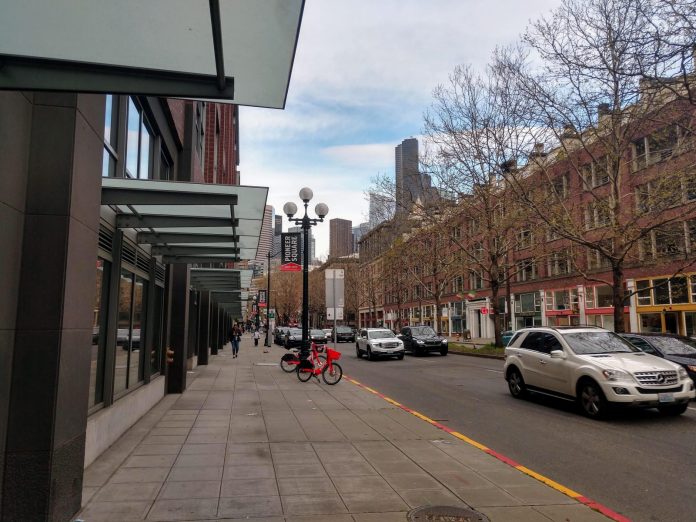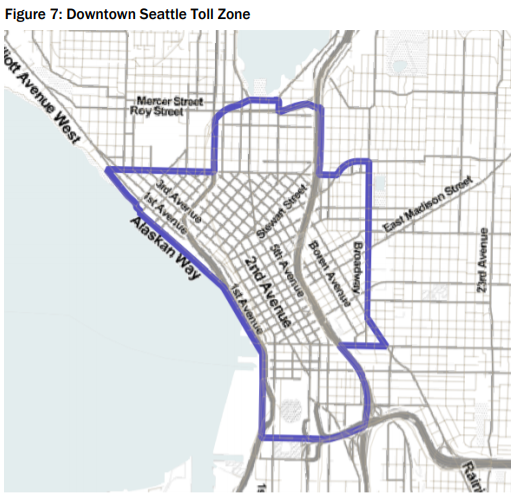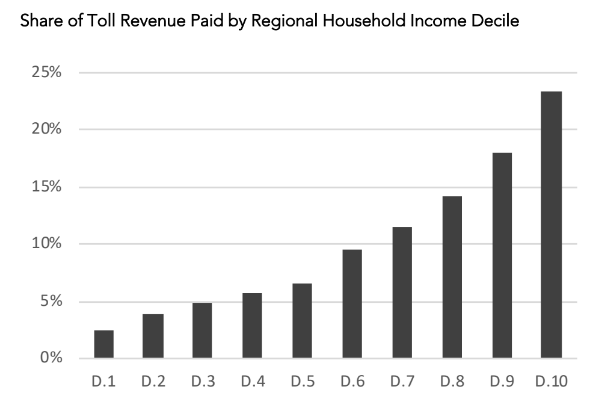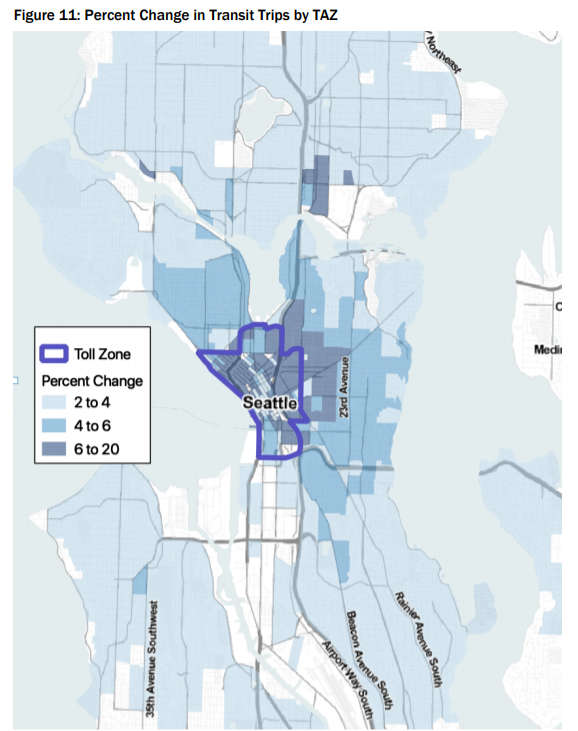Ridehailing behemoth Uber released a study Wednesday looking at the effect that decongestion pricing would have on Downtown Seattle. Turns out it would decongest it. Peak car trips would drop 7%, and automobile travel times to and from downtown at peak times would drop 30% with dynamic tolling topping out at $3.80 in afternoon rush, under the study’s projections. More importantly, pollution would drop, transit ridership would increase 4%, and the city would generate at least $130 million in annual revenue.
Uber tapped ECONorthwest to carry the study and provided it with its carefully guarded trip data to shed light on traffic patterns. ECONorthwest sought to follow the framework the City laid out in its own preliminary study issued in May–which was more focused on table-setting than the nuts and bolts of a program. The four goals laid out were:
- Be equitable
- Have positive climate and health outcomes
- Reduce congestion
- Be feasible to implement
ECONorthwest identified a decongestion pricing plan that appeared to meet all those conditions. And Uber trumpeted the findings and welcomed such a program. One element that seemed especially Uber-friendly was the daily cap of $3.80 in tolls that would mean ridehailing drivers would only pay the toll once or twice before capping out.
The Road to Decongestion: How We Got Here
In 2017, Councilmember Mike O’Brien secured $200,000 for studying decongestion pricing added to the City budget. O’Brien was seeking to prepare for cars diverting and spilling into Downtown streets due to SR-99 tunnel tolling, which was essential to pay for the $4 billion project and particularly its upkeep costs going forward. The Washington Department of Transportation had said that SR-99 tolling would begin in June, though it since delayed tunnel tolling until the fall.
In April 2018, Mayor Jenny Durkan made a big splash when she announced her support for studying downtown decongestion pricing–although she did that the same week as she delayed the Basic Bike Network and halted the Center City streetcar project. Mayor Durkan said she hoped to have decongestion pricing in place by end of her first term in 2021, but that seems unlikely at the speed this process is playing out.
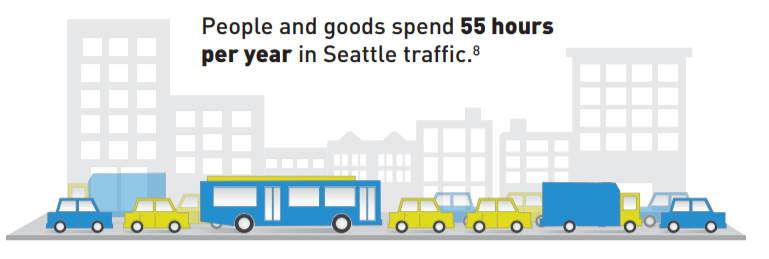
While City leaders were dipping their toes in the decongestion pricing water, they were also considering enacting new fees on just ridehailing trips. Uber had supported Seattle’s exploration of decongestion pricing, but both Uber and Lyft spoke out against targeting only ridehailing services when The Seattle Times broke the story that such a proposal was in the works and being kept under wraps by Mayor Durkan. With the threat of a ridehailing-only fee, decongestion pricing is clearly the more attractive option for Uber. Currently, ridehailing companies pay only 24 cents per trip to Seattle and 33 cents per trip to King County, which is significantly less than cities like San Francisco and Chicago. Also relevant: Uber (and Lyft) continue to hemorrhage billions of dollars, has a questionable business model, and had an initial public offering that went very poorly.
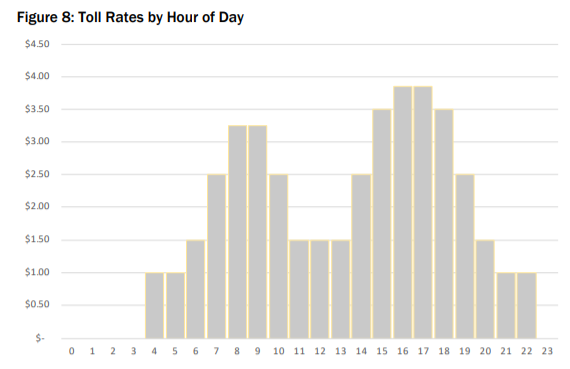
What’s In It for Uber
It’s likely decongestion fees would be tacked onto the cost of ridehailing trips for users, but it would be much less of a competitive disadvantage for Uber because every car would be paying the fee, and the daily cap–if actually implemented–would spare its drivers. That could give Uber and Lyft a competitive advantage over private car ownership. ECONorthwest seems to acknowledge there are better ways to target congestion than this model:
For this white paper, we imagine a single charge – per vehicle per day – that reflects the highest toll rate hour in which the vehicle operates within the downtown toll zone. For example, if a vehicle enters downtown prior to the morning peak when the toll rate is $1.00, parks, but then departs downtown during the afternoon peak when the toll rate is $3.80, then the daily charge would be $3.80. This approach maintains the incentive to minimize exposure to toll costs by avoiding the highest traffic times of day while allowing for a single daily charge to be applied to each vehicle. There are many other tolling approaches that are feasible, and that may more precisely target trips that contribute the most to congested conditions
ECONorthwest Fair and Efficient Congestion Pricing White Paper
For some folks, decongestion pricing would make bikeshare and scootershare trips more attractive, but Uber is in that business too. Pricing could also encourage more people to give up car ownership and that could encourage them to take more ridehailing trips, especially if those trips are faster due to less congestion. Finally, since studies have increasingly linked the recent worsening of urban congestion to the proliferation of ridehailing, Uber backing decongestion pricing could avert backlash and improve public relations.
Making Decongestion Pricing Equitable
The analysis of who would pay the decongestion tolls indicate equity is attainable. In fact, making the impact of a pricing program equitable would be easier than some thought. For starters, the bulk of decongestion tolls would be paid by the wealthy. Under the scenario studied, the highest earning 10% (or decile) or households pays a quarter of tolls, while the lower 50% pay less than a quarter of tolls. While the low-income folks who do pay the tolls would feel them as a larger chunk of their household budgets, clearly the wealthy pay the lion’s share of the tolls levied.
Low-income Toll Rebate Program
One mechanism to make pricing’s impact more equitable is redistributing some of the toll revenue back to low-income people. “Using $50 million per year of the net toll revenues, the City could implement a mobility fairness program,” the study states. “Such a program could target rebates for moderate income downtown employees, low income households’ trips into downtown for critical purposes, and support the general mobility needs of low income Seattle households.”
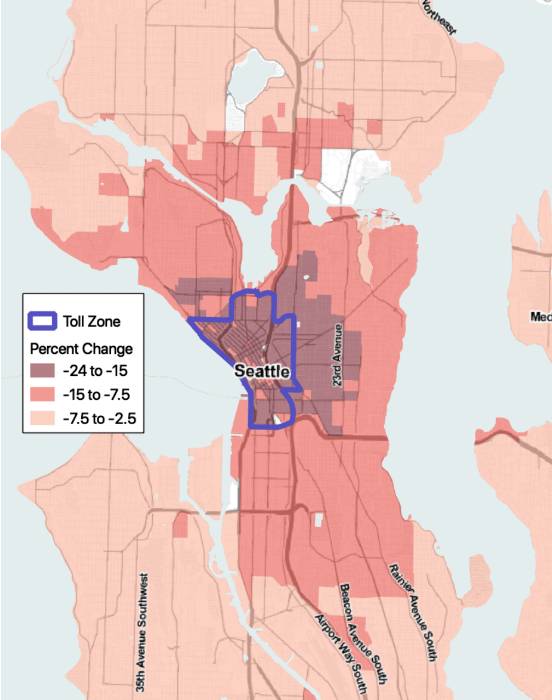
The study lays out some ways to channel $50 million in annual toll revenue back to below median income households, who would pay $31 million in tolls and thus come out ahead.
“Using toll revenues, Seattle based employers could provide employees whose incomes are near or below the regional median a monthly e-purse starting at about $85, or about $1,000 per year,” the study states. “Eligible service expenses might include transit fares, bike-share expenses, shared-ride expenses, parking charges and tolls. For the eligible employees that daily pay the toll to enter downtown Seattle this could entirely offset daily expenses. For employees that pay the downtown toll less frequently, or avoid the toll entirely by taking transit or other means the e-purse disbursements could represent a net fiscal gain.”
The e-purse idea sounded like a light-version of LA Metro CEO Phillip Washington’s idea to make transit fare-free with the revenue from decongestion pricing, which he tossed out there at a transit panel at the Downtown Seattle Association’s State of Downtown conference in February. In fact the e-purse could be administered directly to ORCA transit passes for lower-income folks living or working within the toll zone.
All in all, ECONorthwest and Uber have made an interesting contribution to the decongestion pricing debate. They’ve shown that making pricing an equitable program is very achievable. The proposal to reinvest more revenue back in to below-median income households than they take out seems to indisputably accomplish this. But the wider outcomes of the program are highly equitable, too. The reduction in pollution and the increase in transit speed and reliability would also help low-income communities that bear the brunt of road pollution and clogged transit–and who are most at risk from the climate crisis.
Doug Trumm is publisher of The Urbanist. An Urbanist writer since 2015, he dreams of pedestrian streets, bus lanes, and a mass-timber building spree to end our housing crisis. He graduated from the Evans School of Public Policy and Governance at the University of Washington in 2019. He lives in Seattle's Fremont neighborhood and loves to explore the city by foot and by bike.


